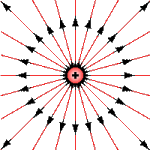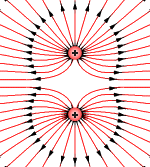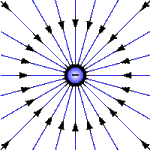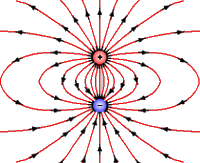Handout #5: Thinking through the idea of Charge
Charged State as a FIELD:
Examples of Fields:
Streetlamp at night
Loud bass from a passing car
Smells near cow pasture
Entering a new country: a field of influence with new laws and rules…
What do these have in common?
-Their influence is spread out over all surrounding space (At every point in space, the field has certain properties)
-Their intensity diminishes with distance, just like the ‘electric field’
Swinging rods experiment:
One charged rod hangs – and if we charge any other rod with any other material and bring it near: we get only either attraction or repulsion, depending on the materials used in the rods and what they were rubbed with.
We can also see the same effect quite clearly with the 'pointy' and 'blunt' ended pieces of Scotch Tape. When the two pieces of tape were stuck together and then peeled apart, we found that the Blunt and Pointy tapes attracted each other. But if a second pair of similarly prepared Blunt and Pointy tapes are brought nearby the first pair, we see that:
Blunt tape repells Blunt tape
Pointy tape repells Pointy tape and
Blunt tape attracts Pointy tape
What does this tell us? There must be TWO types of charged states: we could call them Blunt and Pointy, or we could call them Vitreous and Resinous (after Charles DuFay) or Positive and Negative (after Ben Franklin).
Vitreous and Resinous Attract
Vitreous and Vitreous Repel
Resinous and Resinous Repel
To generalize these results, we could say that: Opposites Attract, and Like repels Like
Also: effects of one type are balanced by the other type.
So how do charged states arise? Where do they come from?
Well, two oppositely charged rods act like a single neutral rod when both are brought near another charged rod that is free to move. In everyday life we experience mostly neutral objects. This suggests that neutral objects may be BOTH simultaneously positively and negatively charged!! If that were true we could get anything to exhibit ‘charged’ effects by finding out how to separate whatever causes one of the charged states from the object…. How? By friction, induction, or conduction!!
And indeed, this is exactly what we see: all neutral objects are attracted when near a charged object - regardless of whether the charged object is positive or negative! But we have seen that attraction only seems to occur between opposite charges. Because neutral objects are as equally attracted to positively charged objects as they are to negatively charged objects, we are led to think that all neutral objects have the potential to become charged both positively and negatively, depending upon the charge of the nearby object to which it is attracted. In other words, if a neutral object is brought near a positively charged rod, it attracts, which indicates that the neutral object has negative charges inside it to attract to the rod. Also, if a neutral object is brought near a negatively charged rod, it also attracts, indicating that the neutral object also has positive charges inside it!
But wait, aren't we talking about neutral objects? Yes - in other words, the reason for their neutrality overall must be because the objects do not have an imbalance of one type of charge - they have equal amounts of both positive and negative charges, so at a large distance they are not attracted to or repelled by other neutral objects, just as we would expect. But on a smaller scale, inside the neutral object that is in the electric field of a nearby charged object, we presume that something must occur, becuase we always see the neutral object attract to either type of charged rod. Therefore we postulate that within the neutral object the positive and negative charges separate from each other: charges that are of the same sign as the external electrical field are repelled away, while charges that are of the opposite sign as the external electrical field are attracted. This charged state separation makes the neutral object exhibit an internal imbalance, where positive and negative charges no longer mingle close together, but separate and move to opposite sides of the object.
So why does the neutral object always attract to both types of charged rod? Because the separation of charged states inside the neutral object brings some of the charges closer to the rod, and pushes the opposite charges away from the rod. The closer charges are always of the opposite type from the external electrical field (this is why they attract to that side of the neutral object in the first place!), and the charges that move farther away, to the far side of the neutral object are always of the same sign as the external electrical field (becuase they are repelled from the external, charged object). Now, because the force of the electrical interaction decreases the farther away you get, the charges that are farther away (which are trying to repel the neutral object from the charged object) have a weaker total force of repulsion than the attractive force felt by the closer charges (which are trying to attract to the charged object). Thus, the attractive force is stronger than the repulsive force, and the neutral object attracts to the charged object.
So we postulate: All neutral objects can be thought of as both positively and negatively charged in equal amounts. Creation of a charged state happens through a process of separating these states from one another (or making the two different states manifest separately from each other) so they no longer neutralize and thus exhibit observable effects.
A corollary to this: There is always an equal potential for the appearance of each type of charged state in any situation because the process of separating these charged states always happens in pairs – you can’t get more of one type of charge than you started with. In other words, there is a conservation of charge.
Something rubbed on itself creates no separation of charged states – each object remains neutral. But with two different types of materials we get separation of charged states. We could say that materials all have a certain “affinity” for becoming charged in a particular way in relation to any given other reference material. That is, which charged state will appear in a particular material is completely relational, and dependent upon the method by which the charged state is made to appear.
Thus, rubbing identical objects doesn’t create a separation of charged states because they each have an equal affinity for their particular charged state – it is a balanced tug-of-war game.
Rubbing non-identical objects can create a separation of charged states because one material may like the positive state while the other likes the negative state when they are considered in relation to each other – the same process (friction, conduction, induction) creates the same amount of opposite charge in each material. Each object can be thought of as winning its tug of war because they played different games: one pulled on the positive rope while the other pulled on the negative rope. Each material wins because the other didn’t pull on the right rope to create a balance inside themselves, but considered as a whole, they are still in balance because they each changed by equal and opposite amounts.
SO:
- there are two charged states, + and – (the specific names are irrelevant)
- opposite states attract, likes repel
- + and – states together “neutralize” each other – i.e. no effects are seen from a distance if both + and – states are present in equal intensity
- charged states can be a stronger or weaker
- charged states can be reasonably thought to exist in all objects
- charged states manifest (can be separated) through:
- friction
- conduction
- induction
Induction Demo:
Bring charged rod near to, but not in contact with: a flame, a water stream, a cotton tuft, tissue paper, etc.
Bring your hand near charged electroscope (i.e. tin-can monster).
It must be that all these objects can be charged, because they respond to an electric field, a field of charge. If something responds to a charged field, then the thing must be in a charged state – as Goethe indicates: “The eyes are formed in the image of light.” The electric field is like a field of tension – like a stretched rubber band, except it can push as well as pull! It simply remains to understand how this tension gets RESOLVED.
Postulate: All charged states seek resolution in the opposite state – i.e. they “want” to become neutral – balanced.
Sometimes in order for this to occur things have to move, or other effects are created (sparks, etc.), so another way of saying this is: it takes a force to keep oppositely charged states away from each other (proportional to the intensity of their charged state and their distance from each other).
Concept of Ground:
So why does touching the electroscope ‘discharge’ it?
Apparently my hand must be a source and receptacle of BOTH types of charge. Why? Because it doesn’t matter what charged state the electroscope is in – touching it discharges it in either case. Therefore my hand must be a source of the oppositely charged state, which, through conduction is able to resolve the electrical tension with the charged state of the electroscope in exactly the right amount to make it become neutral (have an equivalent intensity of both types of charged state).
But during this process my hand does not show any signs of having an imbalance of one type of charged state. It is possible that overall I may become slightly charged, but there will be a balance created between our relative states. Things that can contribute and receive the opposite electrical state without becoming significantly charged themselves we call “A GROUND”. Being a ‘ground’ is always just a question of the extent to which the thing in question can provide resolution to other object’s states of being in electrical tension without itself becoming electrically charged. Therefore the Earth is the penultimate ground (because it is larger than all our experiments and can take and give as much of both types of charges as needed!).
Concept of Conductors and Insulators:
So why doesn’t the electroscope immediately discharge because it is in contact with the air, and the table, which is connected to the earth, etc…?
Because it must be the case that some things are able to ‘hold onto’ their charged state more in relation to others given a particular environment. For example, metals very readily change their charged state, while plastics, dry wood, and air tends to hold onto their charged states.
A ‘ground’ must be a conductor, because it is able to balance other charged states, while the air, which is in contact with the electroscope, only very very slowly resolves the electrical tension, even though ‘neutral’ air has LOTS of both types of charged states in equal amounts.
We call things that tend to change their charged state easily CONDUCTORS and things that tend to hold onto their charged state (even a neutral state as well) INSULATORS. These properties of being a conductor or an insulator are RELATIVE properties. Whether or not something is an insulator or conductor depends entirely upon context (i.e. the other materials that it is in contact with and their nature). So just like you can make a list of materials ordered by their tendency to become positive or negative when rubbd by all the other materials on the list (the triboelectric series), so too can you make a similar list that of materials that is ordered by their relative tendency to act as conductors or insulators. In each case the property is always relative to the position of the given material in the list.
Pictorial Representations of the Electrical Field:
We can represent the field aspect of an object that has a charged state with a picture that is derived from experimental results. The pictures below show lots of lines with little arrows. The lines represent the path that a tiny, point-like “test” object that is positively charged (this is just a convention) would follow if it were free to move in the presence of the indicated charged objects (represented as circles with a + or – inside them).
We could have just as easily taken a “test” object that is negatively charged, in which case all arrows would point the opposite direction, but it is easier to just choose one setup to stick with – the one below is ‘standard’, where lines of movement go AWAY from positively charged objects and TOWARDS negatively charged objects. The results below can be demonstrated clearly with actual charged objects – it is simply a record of how a positively charged object will move when in the presence of the given charged objects – i.e. when the test object is in a given electrical field.
Although the lines below indicate how a positively charged test object would move in the given field, the lines end up giving a picture of the electrical field. Of course to be more accurate you would have to ‘fill in’ all the empty spaces with more lines – in the drawings below only representative field lines are shown so you can distinguish one field line from another. The phenomenon of the electrical field fills space. However, the spacing of the lines does correlate to the strength of the field in a given region of space – i.e. the more field lines per square unit, the higher the strength of the field in that region of space.
| A positive charge: | Two positive charges: |
 |
 |
| A negative charge: | A positive and negative charge: |
 |
 |